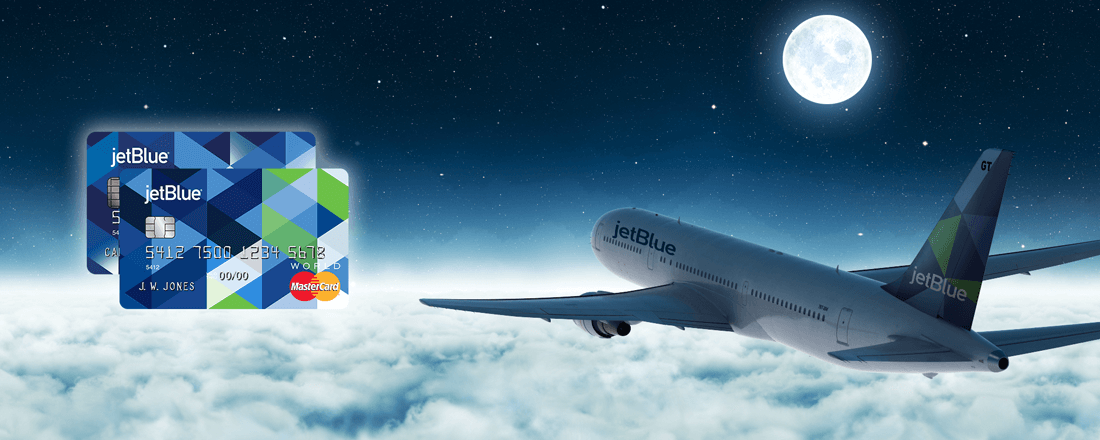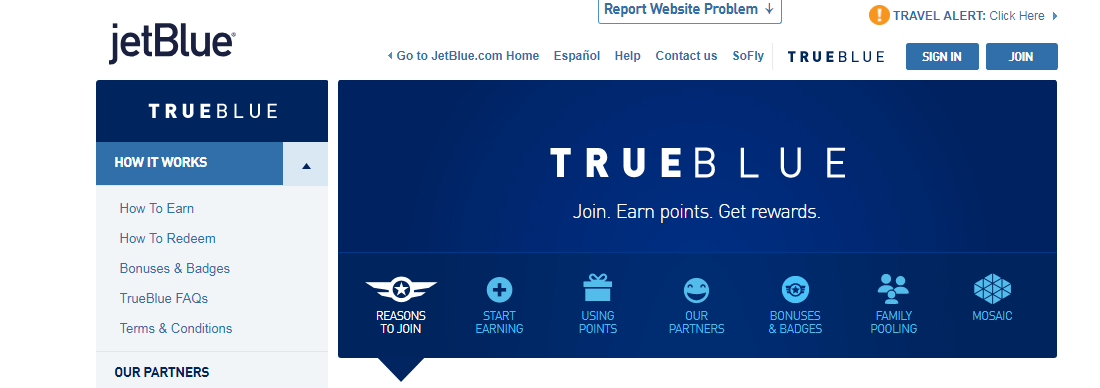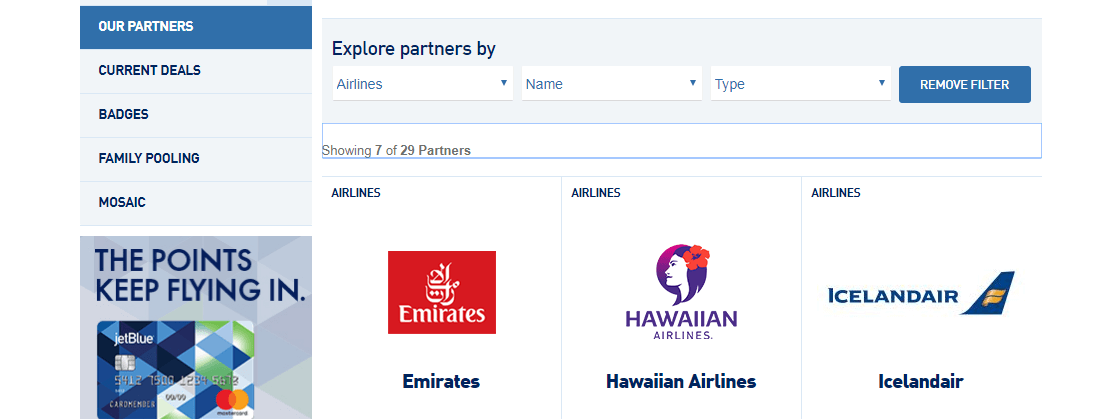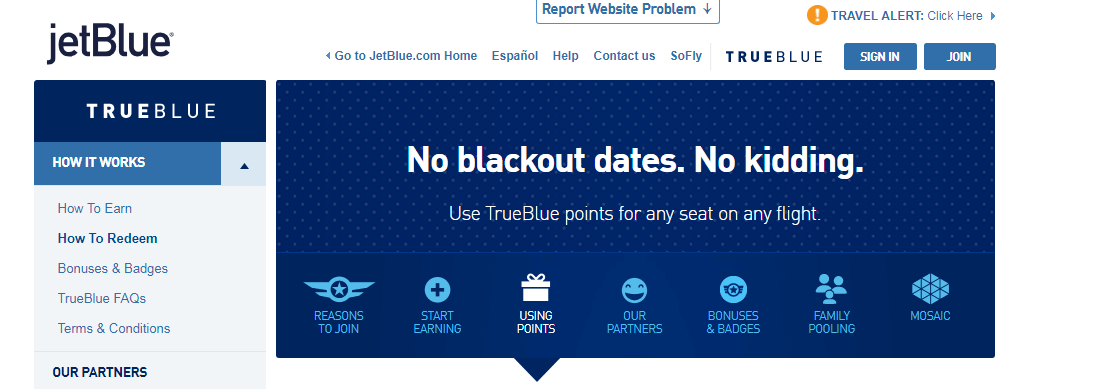
JetBlue offers one of the best economy class experiences of any domestic airline. They serve the United States, the Caribbean and Central America in planes that offer the most legroom in coach, gate-to-gate free WiFi and free DirecTV & Sirius XM entertainment on 10-inch screens. Plus, JetBlue offers three credit card options to earn
This article will cover:
- Credit Cards That Earn JetBlue TrueBlue Points
- JetBlue TrueBlue Loyalty Program
- JetBlue Credit Card Transfer Partners
- How to Get 157,600 JetBlue TrueBlue Points in 4 Months
- How to Earn Even More JetBlue Points Without Flying
- Where You Can Fly With JetBlue TrueBlue Points
- Which JetBlue Credit Card Is Right for You?
Credit Cards That Earn JetBlue TrueBlue Points
There are three credit cards that directly earn JetBlue miles, which are called TrueBlue points, plus a few others that allow their points to transfer into JetBlue’s point system. Barclays took over the JetBlue relationship from American Express in 2016 and now offers two versions for consumers (a no-fee card and one with additional perks for $99) and a business card.
For international travelers, the JetBlue credit cards deserve consideration for a space in your wallet thanks to the chip-and-pin technology and
All three JetBlue credit cards offer:
- No blackout dates on reward flights
- Points never expire
- Points can be used to book any available seat
- Share points with Family Pooling
- 50% discount on food and beverages purchased in flight
Although there are reports of minimum credit scores of 670 to get approved, the JetBlue MasterCards generally require excellent credit for approval.
Barclays JetBlue Card
Very few airline co-branded cards offer a no-fee version. And, if they do, the benefits are stripped down so much that it doesn’t make sense to use the card. This isn’t the case with the JetBlue card.
With the no-fee JetBlue MasterCard, you’ll earn 3x with JetBlue and 2x at restaurants and grocery stores. Plus, you’ll receive a 50 percent discount on in-flight purchases with JetBlue. These benefits make the no-fee JetBlue credit card worthy of your wallet if you fly JetBlue less than twice a year, but you still want to earn JetBlue points.
Barclays JetBlue Plus Card
The JetBlue Plus card offers many extra benefits beyond the increased first-year sign-up bonus that make paying the $99 annual fee a no-brainer. Two benefits alone more than offset the annual fee—5,000 annual bonus points upon card renewal and unlimited 10 percent rebate on reward tickets.
Each year that you renew the JetBlue Plus MasterCard, you’ll receive 5,000 bonus TrueBlue points. With TrueBlue points valued at 1.47 cents, this bonus is worth ~$73 vs. the annual fee of $99.
American Airlines’ cards, for example, offer a 10 percent rebate on reward flights, but those bonus points are capped at 10,000 per year. With the JetBlue Plus card, the 10 percent rebate is unlimited and points post to your account in 4 to 6 weeks. If you redeem 18,000 JetBlue points for a flight from LAX to JFK, you’d receive 1,800 points back, which is worth ~$26.
When you add the $26 rebate value to the $73 in renewal points (5,000 * $0.0147), you’ve now offset the $99 annual fee before getting into any of the other benefits the JetBlue Plus card offers, such as:
- Free checked bag for you and 3 guests on the same itinerary ($25 value per person)
- 6x per dollar on all JetBlue purchases
- 2x per dollar on grocery and dining
- No point redemption blackout dates
- $100 statement credit after spending $100+ with JetBlue Vacations
- Mosaic status after spending $50,000 within a calendar year
If you fly JetBlue more than a couple times a year, it is easy to see how the JetBlue Plus card is the better choice. Since JetBlue’s bag fee is $25, for flyers that like to check bags, even if you fly JetBlue only once a year, the Plus card should be the card you choose.
Barclays JetBlue Business Card
The Barclays JetBlue Business card mirrors the benefits of the consumer JetBlue Plus card in almost every way. You’ll earn 6x with JetBlue and 2x at restaurants. You’ll also receive 10 percent of your points back for redemptions and 5,000 bonus points annually when you renew the card. Plus, you’ll get a JetBlue luggage fee waiver and 50 percent off in-flight purchases. All for a $99 annual fee.
The major difference between the two cards is that, instead of earning 2x on groceries with the consumer JetBlue Plus card, the JetBlue Business card earns 2x at office supply stores.
For more information, click here for an in-depth review of all three JetBlue credit cards.
JetBlue TrueBlue Loyalty Program

The JetBlue TrueBlue loyalty program is revenue-based, which means that the amount of points required to redeem for a ticket is directly related to how much cash it would cost to purchase the ticket. This is a great benefit for low-cost flight redemptions. However, it also means that you can’t maximize the value of your points by redeeming for business and first class flights like you can with other airline programs.
Family Pooling
One of the unique perks of JetBlue rewards is the ability to pool points together with your family to accelerate redemption of free flights. You don’t even need the co-branded credit card to access Family Pooling. Most other domestic airline loyalty programs don’t offer this benefit, and if they do, there is a charge for every point that you transfer from one account to the other.
JetBlue’s definition of “family” is pretty lenient. Each family may contain up to two adults and up to five children. The person designated as Head of Household is the one who will book reservations from the pooled points, so choose wisely.
Since I book all of our reservations, I’ve pooled our family’s points into my account. This is amazing because each of us may not have enough points to book a flight individually, but when we combine points we can redeem for 2 or 3 of the tickets and then pay cash for the others. It’s a huge savings for our vacation budget!
Mosaic Status
I like it when you can earn top-tier status and benefits before you spend your first dollar with an airline or hotel. With the JetBlue Plus card, you can earn JetBlue Mosaic status when you spend $50,000 or more in a calendar year on the card. Without the JetBlue Plus card, to earn Mosaic status you would need to fly 30 segments plus earn 12,000 base flight points or just earn 15,000 base flight points within a calendar year.
Mosaic status offers the following benefits that make flying with JetBlue even better:
- Change and cancellation fees waived
- First and second bag free for you and up to 3 guests on your itinerary (bag fees are $25 for the first bag and $35 for the second per person)
- 15,000 TrueBlue bonus points for achieving Mosaic (~$220 value)
- Complimentary expedited security lane
- Early boarding
- Earn an additional 3 True Blue points per dollar spent with JetBlue
- Complimentary alcoholic beverages during flights
Which perk is your favorite?
JetBlue Credit Card Transfer Partners

As we’ve talked about, you can earn JetBlue points with the Barclays JetBlue and JetBlue Plus cards. But did you know that you can also transfer points to JetBlue?
Citibank has several card options that earn ThankYou points, such as the Citi Prestige, Citi ThankYou Preferred (no longer available) and Citi ThankYou Premier. These points transfer at a ratio of 1,000 ThankYou points to 800 JetBlue points from Citibank into your JetBlue account if you have the Citi Prestige or Citi ThankYou Premier. Transfers from the Preferred card will only net you 500 JetBlue points.
American Express has many credit cards that earn Membership Rewards, such as the American Express Platinum, American Express Gold and American Express EveryDay. Points earned from these cards pool into one account and you can transfer American Express Membership Rewards points to JetBlue at a ratio of 250 Membership Rewards to 200 JetBlue points.
Marriott Hotel + Air travel packages also offer good value with packages of a one-week Marriott stay and JetBlue points starting at 200,000 Marriott points. You can also transfer points from Marriott to JetBlue without the free hotel stay in five increments starting with 1,000 JetBlue points for 10,000 Marriott points (10:1 ratio). The best transfer ratio is 5.6:1 if you transfer 140,000 Marriott points for 25,000 JetBlue points.
How To Get 157,600 JetBlue TrueBlue Points In 4 Months
You can earn as many as 157,600 JetBlue points within four months by using your excellent credit score to maximize your rewards. It’s not something most people will want to do since you’ll need to apply for four credit cards to pull this strategy off, but it could be worth it because you’ll be able to redeem for over $2,300 in flights for you and your family. With so many exotic destinations available on JetBlue, you could be sipping Mai Tai’s on the beach in no time.
Step 1
First month: Apply for the JetBlue Plus MasterCard and spend $1,000 in the first month. This will give you 41,000 JetBlue TrueBlue points (40,000 bonus plus 1,000 for meeting the minimum spend).
Step 2
Second month: Apply for the Citibank Premier card with the 50,000 bonus points offer and spend $4,000 this month. This will give you 54,000 ThankYou points, which convert at a 5:4 ratio resulting in 43,000 JetBlue points.
Step 3
Third month: Apply for the JetBlue Business card, spend $1,000 dollars this month and receive 40,000 bonus points. This will earn you 41,000 TrueBlue points after hitting the minimum spend.
Step 4
Fourth month: Apply for the American Express Premier Gold Rewards card and spend $2,000 to earn the 25,000-point sign-up bonus. You’ll earn a total of at least 27,000 points from the bonus and spend, which converts into 21,600 JetBlue points (conversion ratio of 250 Amex points to 200 JetBlue points).
After four months, you’ll have at least 157,600 JetBlue points which can be redeemed without any blackout dates for any available seat on JetBlue. As an added bonus, when you redeem those points for over $2,300 in flights, you’ll receive a 10 percent rebate of 15,760 points in 4 to 6 weeks that are good towards another $230 in flights.
How to Earn JetBlue Points Without Flying JetBlue
There are many opportunities to earn JetBlue points without paying for a JetBlue flight by using one of the many JetBlue partners. You can pick from a handful of credit card options (discussed above), fly on partner airlines and credit the flights to JetBlue, and rent cars from partner agencies, to name just a few. Visit the JetBlue partner page to see all of the options and latest details.
Earn JetBlue Points on Other Airlines
One of the great benefits of airline partnerships is that you can fly on one airline and credit the flight to another partner airline. Although JetBlue isn’t part of the big alliances like the Star Alliance, OneWorld or SkyTeam, they do have partnerships with select airlines so that you can earn more JetBlue points.
JetBlue’s partner airlines are:
- Emirates
- Hawaiian Airlines
- Icelandair
- JetSuiteX
- Silver Airways
- Singapore Airlines
- South African Airways
Rent a Car With JetBlue Partners
JetBlue has partnered with several car rental agencies to allow you to earn JetBlue points when renting a car. When you rent from Avis, Budget or Payless Rental Car, you will earn 100 JetBlue points per day as a basic JetBlue member (200 for Mosaics) plus receive a discount on your rates.
Where You Can Fly With JetBlue TrueBlue Points

JetBlue offers excellent service and a great in-flight experience, even for Economy tickets. Passengers will be treated to free in-flight DirecTV and SiriusXM Radio entertainment on built-in screens, free 12 to 30 Mbps Wi-Fi to browse the internet, and enjoy unlimited snacks and non-alcoholic beverages.
If only JetBlue flew around the world! JetBlue is a regional airline that limits its service to the Western Hemisphere, with flights as far north as Anchorage, Alaska, and as far south as Lima, Peru. A majority of the flight options are concentrated in the continental United States, the Caribbean and Central America.
I’ve flown JetBlue several times to the Caribbean from Los Angeles and have really enjoyed the experience and customer service.
Which JetBlue Card Is Right for You?
If you’re planning to fly JetBlue within the next 12 months, I would recommend the JetBlue Plus card because the combination of a
If you’re interested in JetBlue but are unsure when you may fly, the no-annual-fee JetBlue card is your opportunity to get acquainted with JetBlue’s TrueBlue loyalty program and earn 2x points through dining and grocery store purchases toward a future vacation.
In reality, you can’t go wrong with either of the personal cards. And a big plus is that the JetBlue credit cards are offered by Barclays, which has not implemented any of the restrictive application rules like Chase, Citi or Bank of America.
